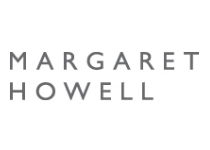Margaret Howell
Accessories / Apparel / Bags / Shoes
Margaret Howell is a contemporary British clothing designer who has worked successfully in both men’s and women’s wear. She has been a strong, if quiet, presence on the British design scene for ne...
Margaret Howell is a contemporary British clothing designer who has worked successfully in both men’s and women’s wear. She has been a strong, if quiet, presence on the British design scene for nearly four decades. Keynote designs are her take on the shirt, gymslip, lace-up shoes, duffle and trench coat. Many have an androgynous quality underlined by a succession of carefully controlled photographic campaigns. These are shot on location in black and white and by such sympathetic spirits as Bruce Weber, Koto Bolofo, and Venetia Scott. After graduating and having been turned down for a job in the BBC make-up department, Howell started making accessories. Her hand-made beads came to the attention of Vogue and led to a meeting with Liz Taylor, then shooting ‘Zee and Co’ in London. The label that bears her name was launched from a kitchen table in South East London in 1972, and was an immediate, if somewhat unexpected, success. In 1972 Howell, with partner Paul Renshaw, began to design make and sell shirts from their flat in Blackheath, South East London. The business grew, encouraged by Paul Smith and leading US retailers, including Jasmin Ram. In partnership with Joseph Ettedgui, a Margaret Howell men’s shop opened in South Molton Street in London in 1976. It was followed by the first wholly owned Margaret Howell shop in St Christopher's Place in 1980. The early 1980s were a period of expansion for the label. Jack Nicholson insisted on wearing his own Margaret Howell corduroy jacket for his role in 1980’s The Shining, prompting an order for 12 duplicates from Stanley Kubrick. 1982 saw Grace Coddington choose a Howell piece as Dress of the Year. A New York shop opened in Manhattan in 1982 and in 1983 the first Margaret Howell standalone shop opened in Aoyama, Tokyo. This rapid expansion caused both business and personal difficulties. The couple divorced in 1987 and Renshaw left the company. It was reorganized in 1990 with the help of Sam Sugure and Richard Craig, who remains today as Managing Director. The new management proved successful and there followed a decade of steady growth culminating in a Paris shop opening in 2009, after the opening of the flagship Wigmore Street shop in 2002. Today Margaret Howell Ltd employs around 300 people in 80 locations.Brand Details
Founder
Paul Renshaw
Designer
Margaret Howell
from
1972to
PresentBrand Strategy
Market segment
Premium
Core business
Apparel
Targets
Men, Women
Margaret Howell Latest News
Margaret Howell with Mizuno
Margaret Howell has collaborated with Japanese label Mizuno again to launch a thermal athleisure line for the cold months coming ahead.
The financial data for this brand is limited.
Contact us for income statementOur team will check for the data and get back to you shortly.
